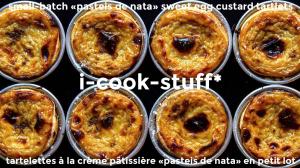You know those Portuguese puff-pastry & sweetened custard tartlets that we all love and buy when we can find them, but never make at home ? Well maybe we all can all give it a try now finally !
I’m not saying that this is the traditional way, but it might be the only way to kindly & encouragingly nudge you into making them soon, perhaps sooner than you think.
I’ve simplified the steps and the custard and reduced the quantities so you can make 12 at a time or a friendlier and easier dozen, so to say.
The original method for this extra sweet custard filling usually requires preparing a cinnamon-flavored simple sugar syrup, combined with warmed whole milk and cream and then the egg yolks and much more flour or cornstarch but instead, I simply infuse & simmer the milk longer to avoid that sugar syrup step and reduce the amount of flour or starch used. My custard proportions are also simplified and the extra flavorings are slightly modified and/or optional.
You can make your own home-made puff-pastry using a food-processor as I do (see recipe here) or simply buy a rectangular sheet from the store, but just make sure it’s all butter because most store varieties substitute all or part of the butter with vegetable oil, which is fine for savory preparations like appetizers but not for sweet preparations. You’ll also add some extra butter before rolling up the pastry and slicing it and shaping it.
You’ll need little Portuguese individual tartlet baking dishes, which are quite small. Mine measure 7 cm wide x 2 cm high and can contain 40 to 50 ml of liquid when filled to the rim, but you can try it out with a mini-cupcake baking dish, simply adjust the quantities for the volumes.
My only advice (as a non-expert) is to keep the custard quite liquid, like buttermilk, and I find that chilling everything is better as well as baking them in a very hot oven, but my oven never gets that hot at 230°C, but it works out fine.
And that’s my story, almost, but there’s a little BONUS*… I published a similar recipe two and a half years ago with a modified and even easier kind of Greek version of custard tartlets using buttered filo sheets and a creamier custard made with evaporated milk and some extras so see recipe here, if you like.
So there you go, 2 options for similar yet different results so YOU CHOOSE which one to experiment with … :)

















